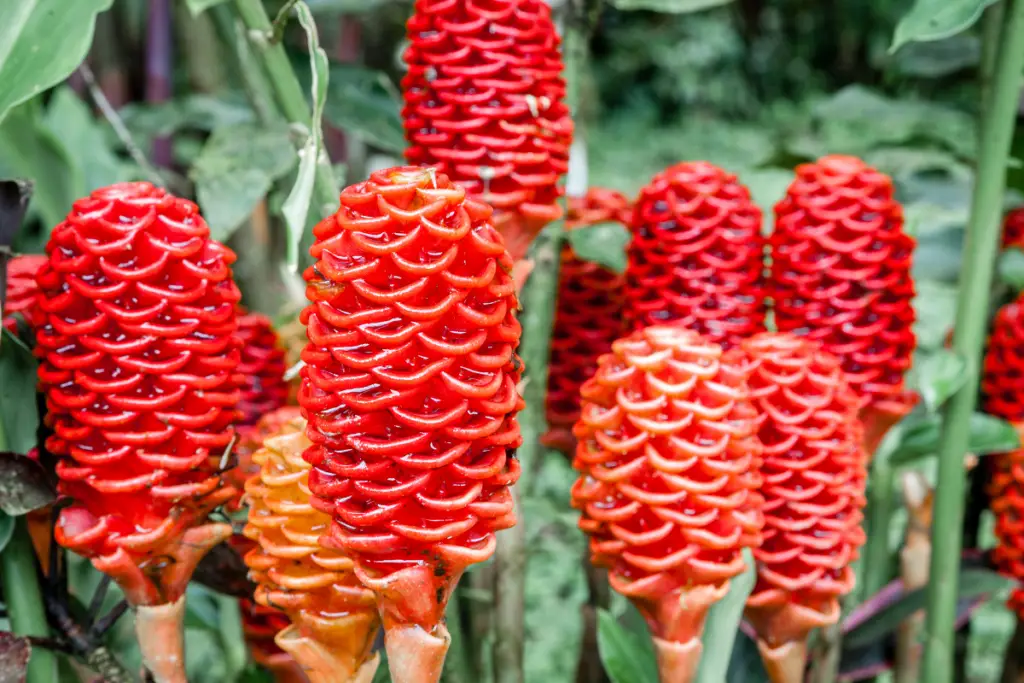Shampoo Ginger Lily, also known as Zingiber Zerumbet, is a tropical plant that is native to Southeast Asia.
It is a unique flowering option that can add a touch of exotic beauty to any garden or home.
The plant is characterized by its cone-shaped blooms that are filled with rich colors and its horn-like appendage attached to its stamen.
Growing Shampoo Ginger Lily is relatively easy. The plant thrives in warm, humid conditions and requires a daily dose of bright light to flourish.
It performs well under full sunlight and also in partially shaded areas. An east-facing window is a good location for the plant, as it exposes it to early morning sunlight.
In terms of soil, the plant prefers nutrient-rich, well-draining soil that is slightly acidic to neutral.

Table of Contents
Understanding Zingiber Zerumbet
Zingiber Zerumbet, commonly known as Shampoo Ginger Lily, is a tropical plant native to Southeast Asia.
It belongs to the Zingiberaceae family, which also includes ginger and turmeric. The plant is prized for its striking appearance and fragrant flowers, which are commonly used in traditional medicine and cosmetics.
This herbaceous perennial plant is characterized by its clumping growth habit, with reed-like, erect stems rising up to 4 feet tall.
In some cases, it can grow up to 6-7 feet tall. The stems are clumped by sheaths of 8-inch long, narrow leaves.
The inflorescence of the Shampoo Ginger Lily grows 2 to 4 inches in length and is cone-shaped, with overlapping bracts that resemble a pinecone.
The flowers themselves are small and white, with a yellow or pinkish-red center. They are fragrant and produce a sweet, spicy aroma.
The plant’s rhizomes, or underground stems, are also used for medicinal purposes. They contain compounds that are believed to have anti-inflammatory, antioxidant, and antimicrobial properties.
They are commonly used in traditional medicine to treat a variety of ailments, including headaches, fever, and digestive issues.
Overall, Zingiber Zerumbet is a beautiful and versatile plant that can be enjoyed for both its aesthetic and medicinal qualities.
With proper care and attention, it can thrive in a variety of settings, from tropical gardens to indoor pots.
Ideal Environment for Shampoo Ginger Lily
When it comes to growing Shampoo Ginger Lily, providing the ideal environment is crucial for the plant to thrive.
This section will cover the light requirements, temperature preferences, and soil conditions that are necessary for the plant to grow healthy and strong.
Light Requirements
Shampoo Ginger Lily requires bright, indirect light to grow well. Direct sunlight can scorch the leaves and cause them to turn yellow.
If grown indoors, it is best to place the plant near a window that receives filtered light. If grown outdoors, the plant should be planted in an area that receives morning sun and afternoon shade.
Temperature Preferences
Shampoo Ginger Lily prefers warm and humid environments. The plant grows best in temperatures between 60°F and 80°F (15.5°C to 26.6°C).
If grown outdoors, the plant should be protected from frost and cold winds. If grown indoors, it is best to keep the plant away from air conditioning vents and drafty areas.
Soil Conditions
Shampoo Ginger Lily requires a nutrient-rich soil with good water drainage capabilities. The plant requires moist, airy soil that supports air, water, and nutrient circulation.
A potting mix containing perlite, coco peat, and orchid bark as part of its ingredients will help increase the drainage of the soil.
The pH level of the soil should be between 6.0 and 7.0. Overwatering can lead to root rot, so it is important to be mindful of the moisture levels in the soil.
In summary, providing the ideal environment for Shampoo Ginger Lily is crucial for the plant to grow healthy and strong.
The plant requires bright, indirect light, warm and humid temperatures, and a nutrient-rich soil with good water drainage capabilities.
By following these guidelines, one can ensure that the plant thrives and produces beautiful, fragrant flowers.
Planting Shampoo Ginger Lily
When it comes to planting shampoo ginger lily, there are a few key factors to consider. This section will cover the necessary steps to plant and care for your Zingiber zerumbet.
Choosing the Planting Location
Shampoo ginger lily is a tropical plant that requires warm temperatures and high humidity. When selecting a location to plant your shampoo ginger lily, choose an area that receives partial to full shade. Direct sunlight can scorch the leaves and cause the plant to wilt.
Preparing the Soil
Shampoo ginger lily requires well-draining soil that is rich in organic matter. Before planting, prepare the soil by adding compost or aged manure.
This will help improve soil structure and provide the necessary nutrients for healthy growth.
Planting Procedure
To plant shampoo ginger lily, dig a hole that is slightly larger than the root ball. Place the plant in the hole and backfill with soil, making sure to cover the roots completely.
Water the plant thoroughly to help settle the soil and remove any air pockets.
When planting shampoo ginger lily in a container, choose a pot that is at least 12 inches in diameter and has drainage holes.
Fill the pot with a well-draining potting mix and place the plant in the center. Water thoroughly and allow excess water to drain away.
With these simple steps, you can successfully plant shampoo ginger lily and enjoy its beautiful foliage and fragrant flowers.
Care and Maintenance
To keep the Shampoo Ginger Lily healthy and flourishing, it is essential to provide it with proper care and maintenance.
This section outlines the watering schedule, fertilizing needs, and pruning tips for the Zingiber Zerumbet.
Watering Schedule
The Shampoo Ginger Lily requires moderate watering, and the soil should be moist but not waterlogged.
Overwatering can lead to root rot, while under-watering can cause the leaves to wilt and dry out.
During the growing season, water the plant once a week, and reduce watering during the winter months.
Fertilizing Needs
To promote healthy growth, the Shampoo Ginger Lily needs to be fertilized once a month during the spring and summer seasons.
A well-balanced fertilizer, diluted to half its strength, or diluted organic manure can be used.
However, it is essential to avoid over-fertilizing, as it can damage the roots and cause leaf burn. During the winter season, stop fertilizing the plant to prevent root burn.
Pruning Tips
The Shampoo Ginger Lily does not require extensive pruning, but it is necessary to remove dead or damaged leaves and flowers to maintain its appearance.
Prune the plant in the early spring before new growth appears, and use sharp and clean pruning shears to prevent the spread of diseases.
In summary, the Shampoo Ginger Lily is a low-maintenance plant that requires moderate watering, fertilizing once a month during the growing season, and minimal pruning.
By providing proper care and maintenance, the Zingiber Zerumbet will thrive and produce beautiful flowers.
Pest and Disease Management
Shampoo Ginger Lily is a hardy plant that is resistant to most pests and diseases. However, it can still be affected by a few common problems.
Here are some tips on how to identify and manage these issues:
Pests
- Aphids: These small, soft-bodied insects can be found feeding on the undersides of leaves. They can cause yellowing and curling of leaves, as well as stunted growth. To manage aphids, use a strong stream of water to wash them off the plant. Alternatively, use an insecticidal soap or neem oil spray.
- Spider mites: These tiny pests can be found on the undersides of leaves, where they suck sap from the plant. They can cause yellowing and stippling of leaves, as well as webbing. To manage spider mites, use a strong stream of water to wash them off the plant. Alternatively, use an insecticidal soap or neem oil spray.
Diseases
- Root rot: This fungal disease can be caused by overwatering or poorly-draining soil. It can cause the plant to wilt and yellow, and may eventually lead to death. To manage root rot, remove the affected parts of the plant and improve drainage. Avoid overwatering and make sure the soil has good airflow.
- Leaf spot: This fungal disease can cause brown or black spots on the leaves, as well as yellowing and defoliation. To manage leaf spot, remove the affected leaves and improve airflow around the plant. Avoid overhead watering and make sure the soil has good drainage.
By following these tips, gardeners can keep their Shampoo Ginger Lily healthy and thriving.
Harvesting and Usage
Once the Shampoo Ginger Lily plant starts to flower, it can be harvested for its fragrant blooms. The flowers can be cut individually or in clusters, and they can be used fresh or dried.
To dry the flowers, cut them in the morning when they are fully open and hang them upside down in a warm, dry place. Once they are completely dry, store them in an airtight container.
The flowers of the Shampoo Ginger Lily are commonly used in Hawaiian and Southeast Asian cuisine. They have a mild, slightly sweet flavor and can be used in salads, stir-fries, and curries.
In addition to its culinary uses, the Shampoo Ginger Lily also has medicinal properties. It is believed to have anti-inflammatory and pain-relieving effects, and it is used to treat various ailments such as headaches, arthritis, and menstrual cramps.
The rhizomes of the Shampoo Ginger Lily plant can also be harvested for their essential oils. The oils are extracted through steam distillation and are used in aromatherapy and perfumes.
Overall, the Shampoo Ginger Lily is a versatile plant with a wide range of uses. From its fragrant blooms to its medicinal properties and essential oils, it is a valuable addition to any garden or kitchen.
Conclusion
In conclusion, growing and caring for shampoo ginger lily (Zingiber zerumbet) is a rewarding experience that can add a unique and exotic touch to any landscape.
This tropical flowering plant is relatively low-maintenance, making it an ideal choice for novice gardeners.
To ensure optimal growth and health, it is important to provide the shampoo ginger lily with adequate sunlight, water, and nutrients.
The plant prefers partial shade and well-draining soil that is kept consistently moist but not waterlogged.
Fertilizing the plant every few months with a balanced fertilizer can also help promote healthy growth.
It is also important to protect the shampoo ginger lily from pests and diseases. Regularly inspecting the plant for signs of damage or infestation and promptly treating any issues can help prevent serious damage.
Overall, with proper care and attention, shampoo ginger lily can thrive and provide a beautiful and unique addition to any garden or landscape.
- How to Dry Basil Leaves: A Professional Guide
- Is an Avocado a Fruit or Vegetable? Simple Answer and Explanation
- Does Pineapple Have Seeds? Exploring the Anatomy of Pineapples
- Blooming Through Winter: Can I Grow Vegetables Indoors in the Winter?
- What Can You Grow in a Greenhouse All Year Round: A Guide to Year-Round Greenhouse Gardening
- Are Blueberries Blue? Debunking the Myth of Their Color
















